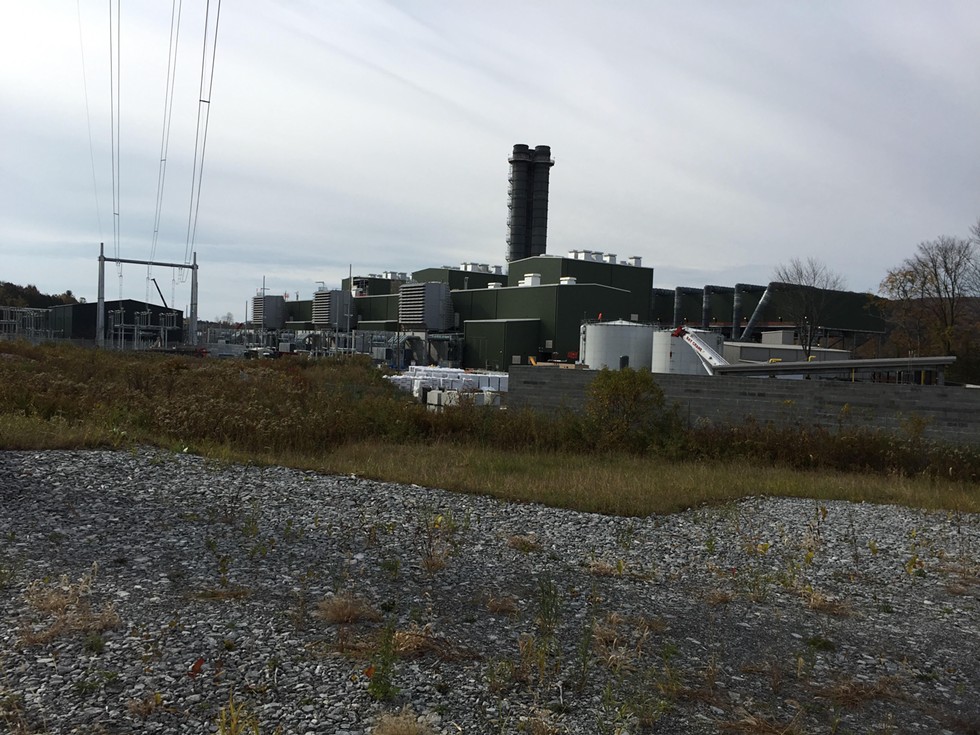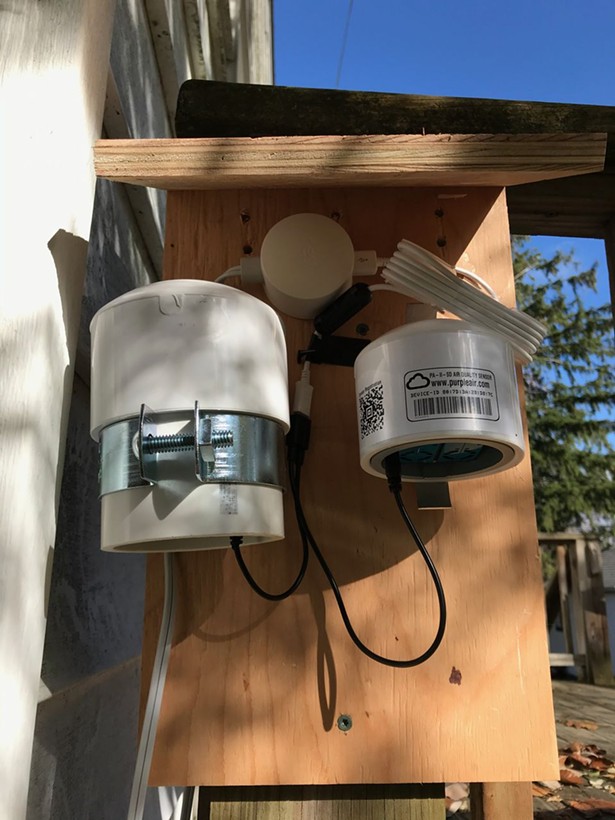Climate change may be a global problem, but air pollution is a local one. Whenever we burn things for heat or energy, the greenhouse gases they produce warm the atmosphere on a planetary scale. But the fine particles that are a more immediate risk to human health settle in the neighborhood—and wreak havoc.
Communities that are home to large-scale fossil fuel combustion have long been paying a steep price in physical health. For decades, it has seemed inevitable that someone would have to pay that toll. After all, energy has to come from somewhere. But with New York now committed to major climate goals, and struggling to figure out how to stop burning things for energy, the prospect of real climate action at a large scale is making another world feel possible. How much life and health are we losing to dirty air? And can we get it back?
A team of New York State analysts recently did a study, as part of the state Climate Action Council’s planning to meet climate goals, to estimate how much human health would improve in New York if the state economy decarbonizes over the next few decades. The bottom line, they found: Decarbonization will yield at least $160 billion worth of better health in New York, once all of the hospitalizations and missed work days and premature deaths are totted up, and most of that benefit comes from better air quality. It’s a cold figure to measure human lives with, but it’s a big one. Carl Mas, lead analyst on the study, put it this way at an October meeting: “Every community in New York is going to substantially benefit in terms of air quality from this work.”
No Safe Levels
In 1994, the year Harvard’s landmark Six Cities study came out, air quality scientists caused a major political ruckus—and have steered the course of both health research and federal environmental regulation ever since. The study tracked air quality and life expectancy across six US cities for more than a decade, and found such a tight linear relationship between local air pollution levels and premature death that it shocked even the scientists conducting the research. “The effects of air pollution were about two years’ reduction in life expectancy,” Harvard environmental scientist Douglas Dockery told the campus magazine in 2012. “It was much, much higher than we had expected.” Since then, the federal Environmental Protection Agency has tightened standards for air pollution several times, and might do so again.
The biggest cause of premature death from air pollution, the scientists found, was fine particulate matter: tiny specks of pollution, no bigger than 2.5 micrometers across, that float invisibly in the air and are easily inhaled deep into the lungs. “You can fit like 20 of these particles in the diameter of a grain of beach sand,” says Mike He, a postdoctoral fellow in environmental health at the Icahn School of Medicine at Mount Sinai. “Because they’re so small, they bypass the body’s normal defense mechanism and go directly into your bloodstream.”
Since 1994, study after study has borne out the conclusions Six Cities reached: Even at low levels, fine particulate matter and other air pollutants carry a cost in human life, and in increased local rates of diseases like asthma, COPD, heart disease, and other cardiovascular ailments. “There really isn’t a threshold for air pollution impacts on health,” says He. “Even at very low levels of air pollution, there’s still an impact.”
In some ways, the problem of air pollution and human health is a lot like climate change itself: There is no safe level of emissions. Every new source of pollution makes the problem worse. But the same dynamic that makes the problem feel overwhelmingly hard to solve is also a powerful argument for action: Every single emission source we manage to clean up will yield a real-world benefit.
He’s own research is finding that recent efforts to curb fossil fuel pollution are already paying off. A New York City law banning the use of heating oil #6—a dirtier fuel than the alternatives, #4 and #2—went into full effect in 2016. In a peer-reviewed study published in the journal Environmental Health Perspectives on December 8, He and his fellow researchers compared air quality in New York City census tracts between 2011 and 2016, and found that even after controlling for traffic and other factors influencing air quality, the ban on #6 significantly reduced fine particles, nitrogen dioxide, and sulfur dioxide.
The upshot is that New York City residents will be healthier and live longer lives because of the ban on heating oil #6. The biggest gains are happening in both the wealthiest and the poorest neighborhoods, He says, because that’s where the oldest buildings are—and the most antiquated heating systems. It’s a small piece of a bigger picture: The air we breathe in the US has been getting cleaner for decades because of the 1970 Clean Air Act and other environmental regulations, and we are living longer as a result. A 2009 study headed by researchers involved in Six Cities found that between 1980 and 2000, improvements in air quality added 1.6 years to the average US lifespan. It’s a start.
Getting a Clearer Picture
Burning fossil fuel harms air quality not just in the city but upstate, too—and so does burning wood, which creates far more particulate pollution than oil and gas to produce the same amount of heat. But keeping track of air pollution is tougher in rural New York than it is in the city. He’s research on heating oil policy relied heavily on data collected by the New York City Community Air Survey, an ongoing program that tracks air quality through about 100 monitors mounted on utility poles throughout the metropolis. Upstate, the lack of widespread air quality monitoring gives researchers a hazier view of local air pollution.
In some places, climate and community advocates are taking citizen science into their own hands. Bill Kish, a Millerton software engineer, helps keep track of four air quality monitoring stations in the Dutchess County town of Dover, where homeowners have volunteered to host backyard gadgets that keep a watchful eye on a nearby power plant. “They’re very simple monitors,” Kish says. “They have a small microprocessor in them, and they have a sensor which is able to detect these fine particles by bouncing a laser beam off them. They’re more or less surrounding the plant.” First brought online in spring 2020, the facility—the 1,100-megawatt Cricket Valley Energy Center—is one of the state’s newest (and largest) fossil fuel power plants. It produces enough electricity from turbines run by burning fracked gas to power a million homes.
With New York’s climate law now guiding decisions at the Department of Environmental Conservation (DEC) and other state agencies, a project like Cricket Valley would have an uphill battle getting state approval today. The DEC recently denied permits to developers seeking to rebuild and expand the Danskammer and Astoria gas-fueled power plants, citing the state’s 2019 climate law as a reason for the decision, and has proposed new agency guidance that will likely make it tougher for existing fossil-fuel projects to get ordinary permit renewals as well. But like other communities that are home to large fossil fuel power projects, Dover is stuck with the plant—and its local health impacts—until New York State builds enough renewable energy to start bringing its existing power plants offline.
Cricket Valley has been in the works for more than a decade. Many locals didn’t know it was coming until the chimneys began rising alongside nearby Route 22. “There’s 300-foot smokestacks. Until those went up, people didn’t really necessarily know what was happening,” says Jess Mullen, a member of the New Paltz Climate Action Coalition. The group initially fought to get Cricket Valley shut down. As the clock ticked toward the plant coming online, they formed a partnership with the Environmental Health Project, a nonprofit in southwestern Pennsylvania that tracks the health impacts of hydraulic fracturing and shale gas development, to monitor Cricket Valley’s impact on local air quality and health.
The four air quality monitors in Dover are part of that partnership, but they also feed data into larger citizen science networks. Each station has a sensor from PurpleAir that measures fine particulate pollution in real time, and uploads live data to PurpleAir’s worldwide map. PurpleAir sells the devices for about $250, and anyone can install one in their backyard to collect and share air quality data.
Of course, Dover has many sources of air pollution besides Cricket Valley. Vehicle traffic, local home heating systems, and other major air pollution sources all make the same kinds of pollutants that are caused by burning natural gas at the plant—and may in fact be contributing more to local air quality problems than the plant is. But by placing monitors in a ring around the facility, and observing how sharp pollution spikes correlated with operations at Cricket Valley, the project was able to pick up clear impacts from the plant on local air quality. “In the homes and the areas surrounding the plant, depending on which way the wind blows and what the atmospheric conditions are and how much gas the plant is burning at any given moment, there are very high spikes of both PM 2.5 [fine particulate matter] and volatile organic compounds,” Kish says.
Fossil fuel combustion isn’t the only thing the monitors in Dover are picking up. Last summer, when wildfire smoke from forest fires raging on the West Coast (another manifestation of climate change) were dimming skies across the Northeast, the data showed massive spikes in pollution. “The monitors went nuts when that happened,” Kish says. “It was really scary, actually.”
In recent years, notes He, scientists have made strides in studying air quality in rural areas by combining monitor data—like the data collected in Dover—with satellite imagery and advanced modeling tools. “We can incorporate populations we weren’t able to incorporate before,” He says.
Urgent Work in a Changing World
If New York State succeeds in phasing out most combustion-based heat and power over the next few decades, a goal now enshrined in the state’s 2019 climate law, air quality across the state will likely improve significantly, especially near large pollution sources like power plants. Improvements to human health and lifespan are bound to follow—and in a world transformed by the pandemic, better air quality is a more urgent goal than ever. Studies are already showing that in areas with poor air quality, COVID-19 infection is more likely to be fatal.
For scientists working at the intersection of human health and politics, it’s vital to figure out what impact environmental policies will have on the real world. But it can be tough to tease out the effects of new laws from other ways in which the world is constantly changing. It’s worthy work, if you ask He. “Recently, I’ve been realizing the importance of including the policy aspect, because I want my research to do something for people in the world,” He says. “If it doesn’t impact any sort of policy, that isn’t putting the research to its full potential.”
This article will be published in the January 2022 issue of Chronogram.



















